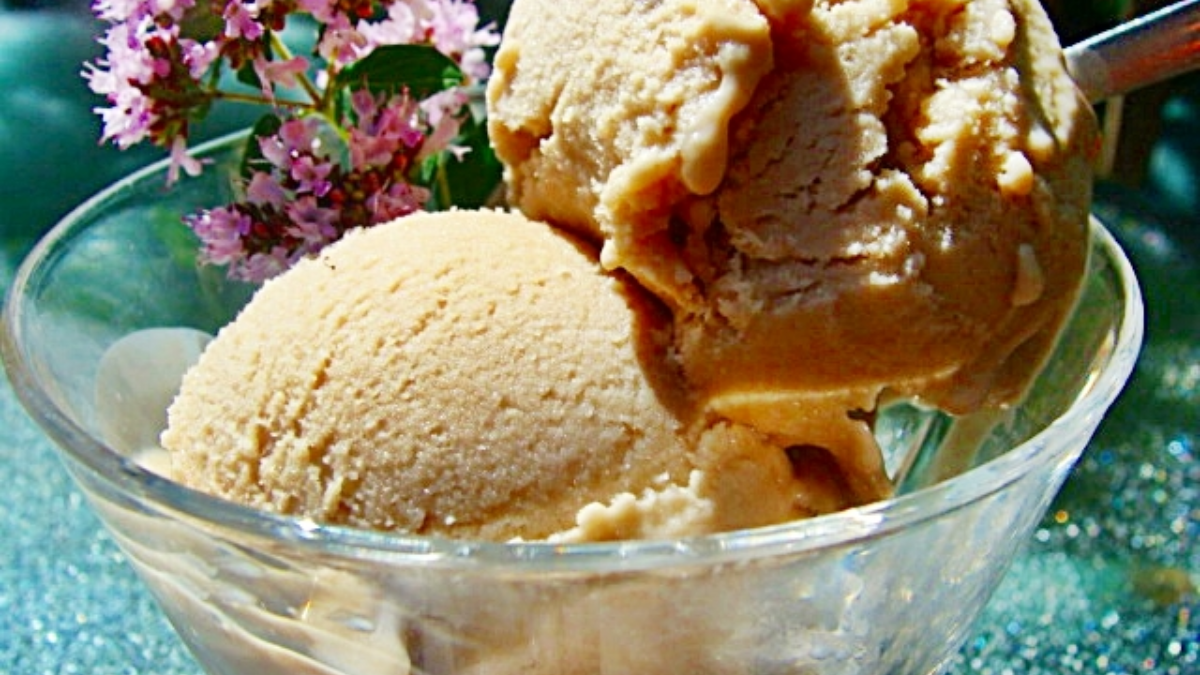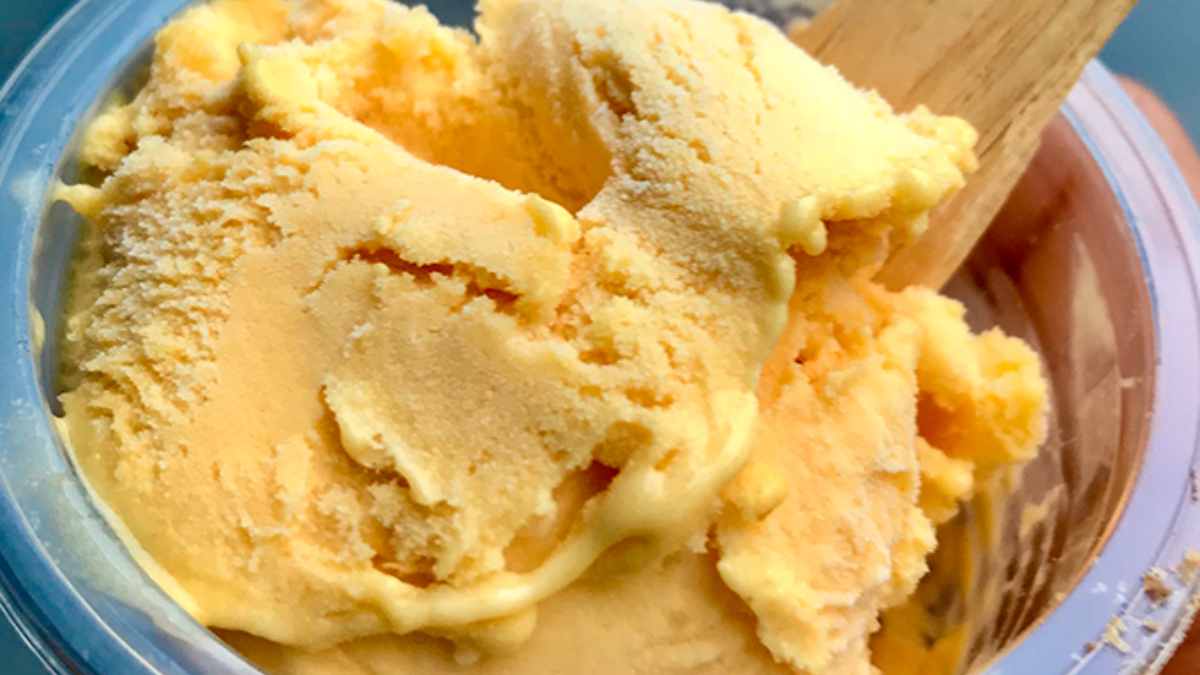The fruit lucuma is indigenous to Peru. This superfood from Peru was dubbed the “Gold of the Incas.” For a delicious ice cream packed with the benefits of superfoods, check out the recipe for lucuma ice cream, a Peruvian superfood. This delectable ice cream has a flavor that is a cross between mango and pumpkin. With undertones of cinnamon, it is delicious.
One of the strangest tropical fruits comes from South America, where it is very well-liked. It is a tree fruit raised in Bolivia, Chile, Ecuador, and Peru’s Andean regions. The fruit’s three-inch length and egg-like oval, curved shape gave it the English name “eggfruit.”
Depending on the variety, the flesh ranges from yellow to orange and softens with age. Orange in color, lucuma pulp has a distinct, sweet aroma resembling maple syrup or sweet potatoes. The skin and large seeds are discarded, and only the flesh is consumed.
How to Make Lucuma Ice Cream?
Fruits like bananas, lemons, pineapples, strawberries, and blueberries, as well as sweet treats like chocolate, caramel, dulce de leche, cinnamon, and vanilla, as nuts like almonds, cashews, macadamias, and peanuts, are frequently combined with lucuma.
Lucuma is a fruit that is accessible all year long, but the summer is when it is most popular. Lucuma is available in fresh, frozen, and pulp in Latin grocery stores. Lucuma powder may be available at your neighborhood grocery shop if frozen lucuma pulp is not an option. Approximately 1/4 cups of lucuma powder can replace the lucuma pulp in this ice cream.
Substitute 1/2 cup dulce de leche for the evaporated milk in this ice cream for a delectable upgrade. Your particular preferences will determine the amount. You might not want to use the entire cup of sugar specified in the recipe because dulce de leche contains sugar in contrast to evaporated milk and will make the ice cream sweeter. The ice cream has a richer, more delicious consistency thanks to dulce de leche.
Ingredients:
- One and a half cups of evaporated milk
- Eight large yolks of eggs
- One cup sugar
- 1 cup of pureed frozen or thawed lucuma pulp
- One teaspoon of Pure vanilla extract
- 2 cups whipping cream
Instructions:
- Milk should be heated to scalding in a medium saucepan over medium-high heat (edges of milk will begin to bubble, but milk will not boil). In the meantime, mix the sugar and egg yolks in a separate bowl until they are thick and light yellow. Return the mixture to the pan after whisking the heated milk pan and stir into the egg yolk mixture gradually. Cook, stirring regularly until the milk mixture thickens (the quick-read thermometer should read 170°F). The milk mixture should not be allowed to boil. Put hot custard in a basin and stir in the thawed lucuma pulp. Cool off completely.
- Heavy cream should be whipped or blended in a medium bowl until stiff peaks form (the cream will hold its frame and cling to the edges of the whisk when raised). Once combined, fold 1/3 of the whipped cream mixture into the chilled summa custard. Fold the remaining whipped cream in gently. Transfer the lucuma-cream mixture to a 112-quart bowl or loaf pan and wrap it in plastic. Up to one week may pass between freezing until firm.
- Serve by scooping comma ice cream into a bowl and, if desired, topping with dulce de leche.
What does Lucuma Ice Cream Taste Like?
Some have compared the lucuma flavor to being creamy, citrusy, and slightly sweet or maple-flavored. It’s been compared by others to sweet potatoes. Moreover, it smells sweet. It’s one of Peru’s most popular ice cream flavors because of how well-liked it is there.
The ice cream is fairly accurate but much smoother, thanks to the excellent flavor preservation provided by lucuma powder. With a hint of caramel or maple, Lucuma has a creamy, citrusy flavor. It cannot be easy to pinpoint the exact flavor of fruits like this, so the next best thing is to compare it to other fruits or foods you can recognize.
It is called the ice cream fruit because of its texture, which resembles custard. Which is this? The Lucuma is equally as delectable. It has smoky undertones reminiscent of cinnamon or nutmeg and tastes like a custardy mango or pumpkin. The flavor of Lucuma is slightly tart and has hints of maple syrup when it is fully ripe.
What Complements Lucuma well?
A more bitter herbal tea or coffee complements the Lucuma’s slightly sweet flavor perfectly. Use a spoonful or two of powder to sweeten a single-serving smoothie. In terms of flavor, With yogurt or oatmeal and cacao nibs, coconut flakes, almonds, cashews, or cashews on top, mix in the necessary amount of lucuma powder. A common flavoring for foods like ice cream and other desserts is Lucuma.
Additionally, it can provide a bit of natural sweetness to homemade nut glasses of milk, yogurt, oatmeal, smoothies, and other beverages. It flavored other dishes like yogurt, cereal, and ice cream. Once cut open, the flesh holds even more surprises. The texture mirrors a hardboiled egg yolk—creamy but dry and crumbly. Though it can be enjoyed fresh and eaten as is, it’s more commonly used as a flavoring for yogurt, ice cream, desserts, milkshakes, and juice.
Is Lucuma Healthy for the Skin?
Lucuma is a potent, natural antioxidant that fights oxidative stress-related aging signs, whether consumed as a fruit or in powder form. It is brimming with nutrients that benefit our skin, including zinc, beta-carotene, potassium, calcium, magnesium, phosphorus, fiber, and vitamin C.
The lucuma fruit is rich in insoluble dietary fiber. This type of fiber gives stools bulk and aids in the elimination of waste. High levels of polyphenols and carotenoids, antioxidants that can help prevent diabetes, heart disease, and cancer, can be found in Lucuma. The edible skin can be either yellow or red.
The antioxidants in lucuma powder are primarily responsible for its health advantages because they shield the body’s cells from free radicals created when food is broken down. The body can turn some carotenoids, like beta carotene, into vitamin A, which has antioxidant properties. Provitamin A carotenoids, such as beta carotene, are abundant in loquats.
Free radical damage can result in deadly conditions like cancer. Another benefit of Lucuma is that it contains a lot of fiber. Your digestive system runs more smoothly when you consume fiber. It also has trace amounts of several vitamins and minerals, but not enough to serve as a significant source of these nutrients.
Is Lucuma Ice Cream Nutritious?
A delicious superfood, Lucuma, contains minerals like iron and potassium and energizing B vitamins. The ice cream’s base is made of cashew nuts, making it dairy-free and incredibly creamy. Compared to other sweeteners, lucuma powder is lower in sugar and higher in fiber and antioxidants, making it a healthier option than most. Potassium, riboflavin, niacin (vitamin B3), and other nutrients are all abundant in lucuma powder.
- Nutrients per serving
- Approximately 2.5 tablespoons of lucuma powder, or 40 grams, contain the following ingredients:
- calories: 140
- One gram of protein
- Fat: 0 grams
- 35 grams of carbohydrates.
- Fiber: 11 grams
- 11 grams of sugar
Although Lucuma may be a better option than other sweeteners, it still contains enough sugar not to be consumed in large amounts. This incredibly healthy Peruvian fruit’s delicious maple/apricot flavor pairs perfectly with bananas, coconut cream, and other tropical fruits.
As a result of its abundance of b vitamins, beta carotene, and numerous trace minerals, it is the ideal way to give this delicious dairy-free dessert a superfood boost.
How do You Eat Lucuma?
The flavor of lucuma powder, used in baby food, cakes, muffins, bread, and nut kinds of butter, is similar to brown sugar. A popular ice cream flavor in Peru, Lucuma is frequently combined with milk or fruit juice to create shakes or smoothies. You can also sprinkle the powder on your oatmeal, yogurt, and cereal.
Although Lucuma can be consumed raw, it’s usually found as a dried, powdered supplement used as a substitute for sugar. Stir it like regular sugar or honey to complement the slightly sweet flavor of Lucuma, which goes well with more bitter herbal teas or coffee.
In addition to these dishes, Lucuma tastes great in ice cream, yogurt, oatmeal, chia pudding, and nut kinds of milk. Use one to two tablespoons of lucuma powder to sweeten a single-serving smoothie.
How is Lucuma Powder Used?
Lucuma has a creamy texture and a light brown color when dried and ground into a powder. This versatile ingredient is added as a natural sweetener and flavor enhancer to beverages, desserts, and sweet snacks. Use it to give raw slices a caramel sweetness by mixing it with almond or sugar-free peanut butter for a quick sweet treat. It can also be added to simple beverages like fruit juice or coconut water.
Even now, it’s fashionable to add lucuma powder to coffee to give it a sweet, caramel flavor. Because of its fruity flavor, Lucuma can be used as a low-GI natural sweetener. As a result, helping to stabilize blood sugar which is important for all bodily cell function—and balance energy levels is safe for people with diabetes and beneficial for the rest of us.
Conclusion
The Andean valleys’ native Pouteria lucuma tree produces the lucuma fruit. It has a rounded shape, a yellow pulp, and skin that ranges in color from yellow to brown. Typically, only the fruit’s flesh is consumed; the skin and seeds are discarded.
The dried, powdered form of Lucuma is most frequently found in the United States, even though the fresh fruit is more popular in South America. Because it can be used in place of sugar, Lucuma has become increasingly popular recently. The distinct sweetness of its flavor has been likened to that of maple, pumpkin, sweet potato, and caramel.

